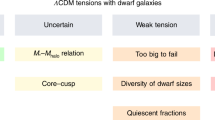Abstract
The standard model for the formation of structure assumes that there existed small fluctuations in the early universe that grew due to gravitational instability. The origins of these fluctuations are as yet unclear. In this work we propose the role of dark matter in providing the seed for star formation in the early universe. Very recent observations also support the role of dark matter in the formation of these first stars. With this we set observable constraints on luminosities, temperatures, and lifetimes of these early stars with an admixture of dark matter.





Similar content being viewed by others
References
Ade, P.A.R., et al.: Planck 2015 results XIII. Cosmological parameters. Astron. Astrophys. 594, A13 (2016)
Arun, K., Gudennavar, S.B., Sivaram, C.: Dark matter, dark energy, and alternate models: a review. Adv. Space Res. 60, 166 (2017)
Arun, K., et al.: Alternate models to dark energy. Adv. Space Res. 61, 567 (2018)
Barkana, R.: Possible interaction between baryons and dark-matter particles revealed by the first stars. Nature 555, 71 (2018)
Barkana, R., Loeb, A.: In the beginning: the first sources of light and the reionization of the universe. Phys. Rep. 349, 125 (2001)
Bowman, J.D., et al.: An absorption profile centred at 78 megahertz in the sky-averaged spectrum. Nature 555, 67 (2018)
Firmani, C., Avila-Reese, V.: Physical processes behind the morphological Hubble sequence. Rev. Mex. Astron. Astrofís. 17, 107 (2003)
Gelmini, G.B.: DAMA detection claim is still compatible with all other DM searches. J. Phys. Conf. Ser. 39, 166 (2006)
Huang, X-J., Zhang, W-H., Zhou, Y-F.: 750 GeV diphoton excess and a dark matter messenger at the Galactic Center. Phys. Rev. D 93, 115006 (2016)
Narain, G., Schaffner-Bielich, J., Mishustin, I.N.: Compact stars made of fermionic dark matter. Phys. Rev. D 74, 063003 (2006)
Price, D.J., Bate, M.R.: Inefficient star formation: the combined effects of magnetic fields and radiative feedback. Mon. Not. R. Astron. Soc. 398, 33 (2009)
Sivaram, C., Arun, K.: New class of dark matter objects and their detection. Open Astron. J. 4, 57 (2011)
Sivaram, C., Arun, K., Kiren, O.V.: Forming supermassive black holes like J1342+0928 (invoking dark matter) in early universe. Astrophys. Space Sci. 363, 40 (2018)
van den Bosch, F.C.: The origin of the density distribution of disc galaxies: a new problem for the standard model of disc formation. Mon. Not. R. Astron. Soc. 327, 1334 (2001)
Author information
Authors and Affiliations
Corresponding author
Additional information
Publisher’s Note
Springer Nature remains neutral with regard to jurisdictional claims in published maps and institutional affiliations.
Rights and permissions
About this article
Cite this article
Arun, K., Gudennavar, S.B., Prasad, A. et al. Effects of dark matter in star formation. Astrophys Space Sci 364, 24 (2019). https://doi.org/10.1007/s10509-019-3511-6
Received:
Accepted:
Published:
DOI: https://doi.org/10.1007/s10509-019-3511-6




